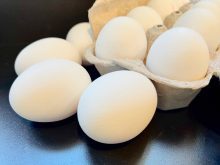Could Flin Flon be the Napa Valley of the North? An entrepreneur from the rugged Manitoba mining town is planning to launch the region’s first – and likely the world’s only – birch winery.
After several years of planning, Doug Eryou says he’s ready to build his winery in nearby Bakers Narrows and bottle his first commercial batches of birch wine by midsummer.
His unique wines are made from a foundation of sap, tapped from local birch trees, along with juice from berries. Birch sap contains about two per cent natural sugars, compared to four per cent for maple sap. In spring, when the sap is running, a single birch tree can yield 3.5 gallons per day.
Read Also

Mazergroup’s Bob Mazer dies
Mazergroup’s Bob Mazer, who helped grow his family’s company into a string of farm equipment dealerships and the main dealer for New Holland machinery in Saskatchewan and Manitoba, died July 6 from cancer.
Early in the run, a “slight sweetness” in the sap is detectable, but it dwindles over time.
“If you cook anything with it, like a carrot, parsnip, or a turnip, or use it to make a pot of coffee, the flavour that it brings out is just unbelievable,” said Eryou, owner and president of Channel Development Corporation.
To add an alcoholic “kick” to the beverage, it’s necessary to add berry sugar prior to fermentation. Apart from a fellow in Newfoundland who is also interested in the concept, he’s probably the only birch sap wine maker on Earth, he said. In Japan and other boreal countries, they don’t make wine, but consume the sap as a health tonic due to its mineral content.
Birch sap gives the wine a unique taste, he said, but to add flavour and colour, he adds a berry component, such as local haskap berries, wild cranberries, blueberries or saskatoons, which are high in antioxidants. The dessert wines are made from a mixture of tree saps, maple syrup and berries.
“People are starting to realize that there are harvestable things in the North and we know they’re high in antioxidant value,” he said.
Eryou has been making samples and experimenting for a few years. Agriculture and Agri- Food Canada funded a feasibility study in 2008 and provided a further grant, administered by the Manitoba Rural Adaptation Council, for the development of a business plan.
Now Eryou is actively working on everything from the winery logistics to labels.
“We’re toying with the idea of having the winery resemble in some way the shape of a mine head frame,” he said in a telephone interview. “That’s similar to someone trying to keep the old grain elevator look on the Prairies.”
Eryou hopes to attract tourists keen on northern adventures to the seven-acre site, which, if you follow the red line on a large provincial map, represents the point where Hwy. 10 runs out of road.
It is, however, close to a provincial campground, not far from Flin Flon’s airport, and set in the iconic Canadian Shield landscape – deep forests, rocky outcroppings and lakes teeming with fish.
“Wineries have become a destination point for tourists and we have a gorgeous area for tourists,” he said.
Eryou initially plans to produce 5,000 cases of wine a year at the winery, which will be built on a hill in order to take advantage of “old-fashioned” gravity flow for the production process. The project includes a wine store and will create about 10 jobs, plus a hefty amount of casual work for pickers and tappers. Eryou said his goal is to make the operation energy self-sufficient, heated with geothermal energy, solar and possibly wind, and subject to a carbon audit. That will add to the initial cost of the facility, projected to be somewhere around $1 million. However, that investment will pay off in lower utility bills and operating costs, he added.
He estimates that the table wines would range in price from $20 to $30 per 375-ml bottle, while the dessert wines would range from $30 to $80 per 375- ml bottle.
Eryou’s wine will not be available in Manitoba Liquor Marts but may be sold in some private wine stores. It will be available by mail or phone order, online, or in person.
The project will create economic spinoffs in the northern Manitoba community, along with employing people to pick the berries and to hand paint the wine bottles, he said.
“This will bring new economic activity to an area that’s been living off of resource extraction, which comes at a high cost,” he said.
He also hopes farmers in the southern parts of the province and nearby Saskatchewan will plant some of their acres or shelterbelts to berry bushes of various kinds to supply his winery.
daniel. [email protected]
———
“We’retoyingwiththeideaofhavingthewinery resembleinsomewaytheshapeofaminehead frame.That’ssimilartosomeonetryingtokeep theoldgrainelevatorlookonthePrairies.”
– DOUG ERYOU


















